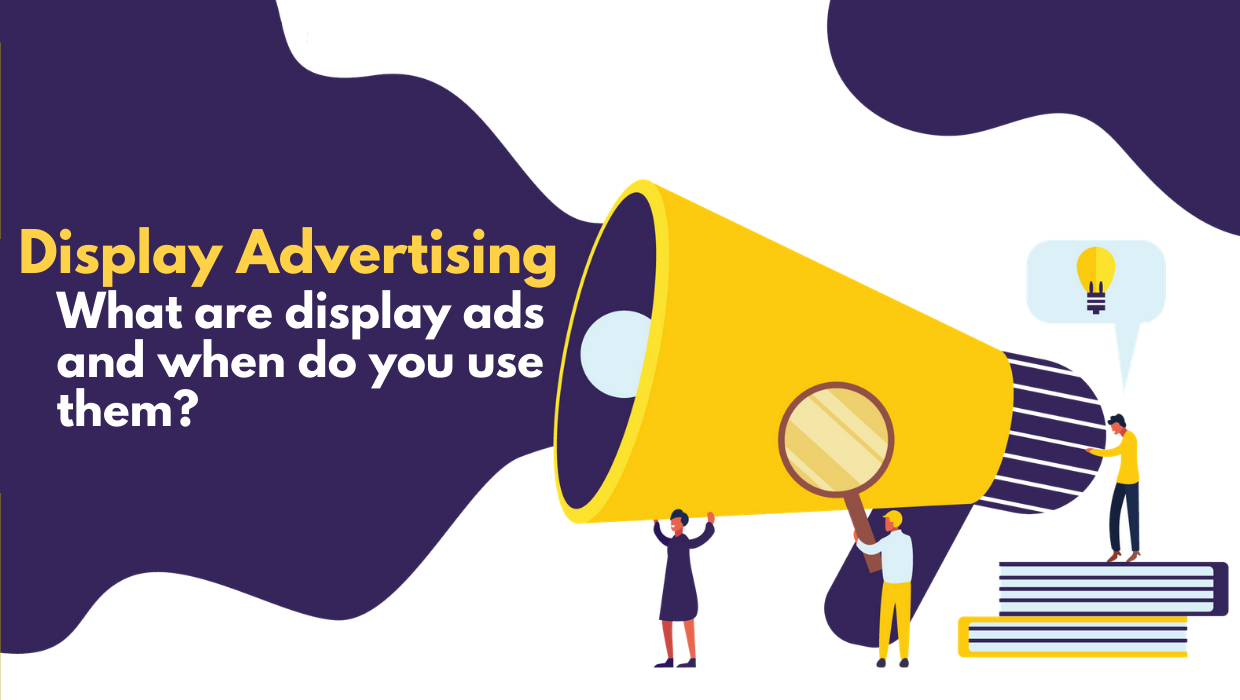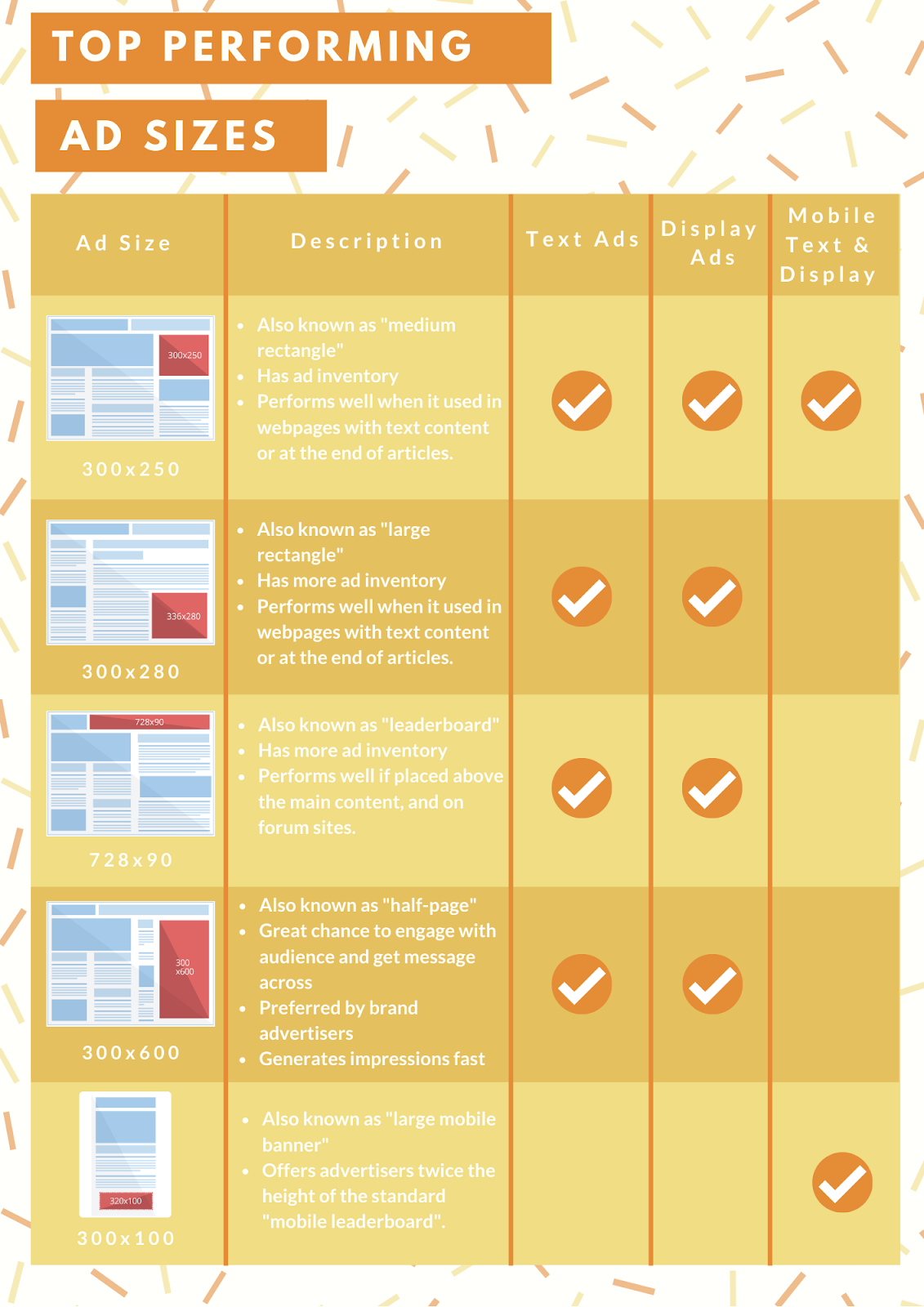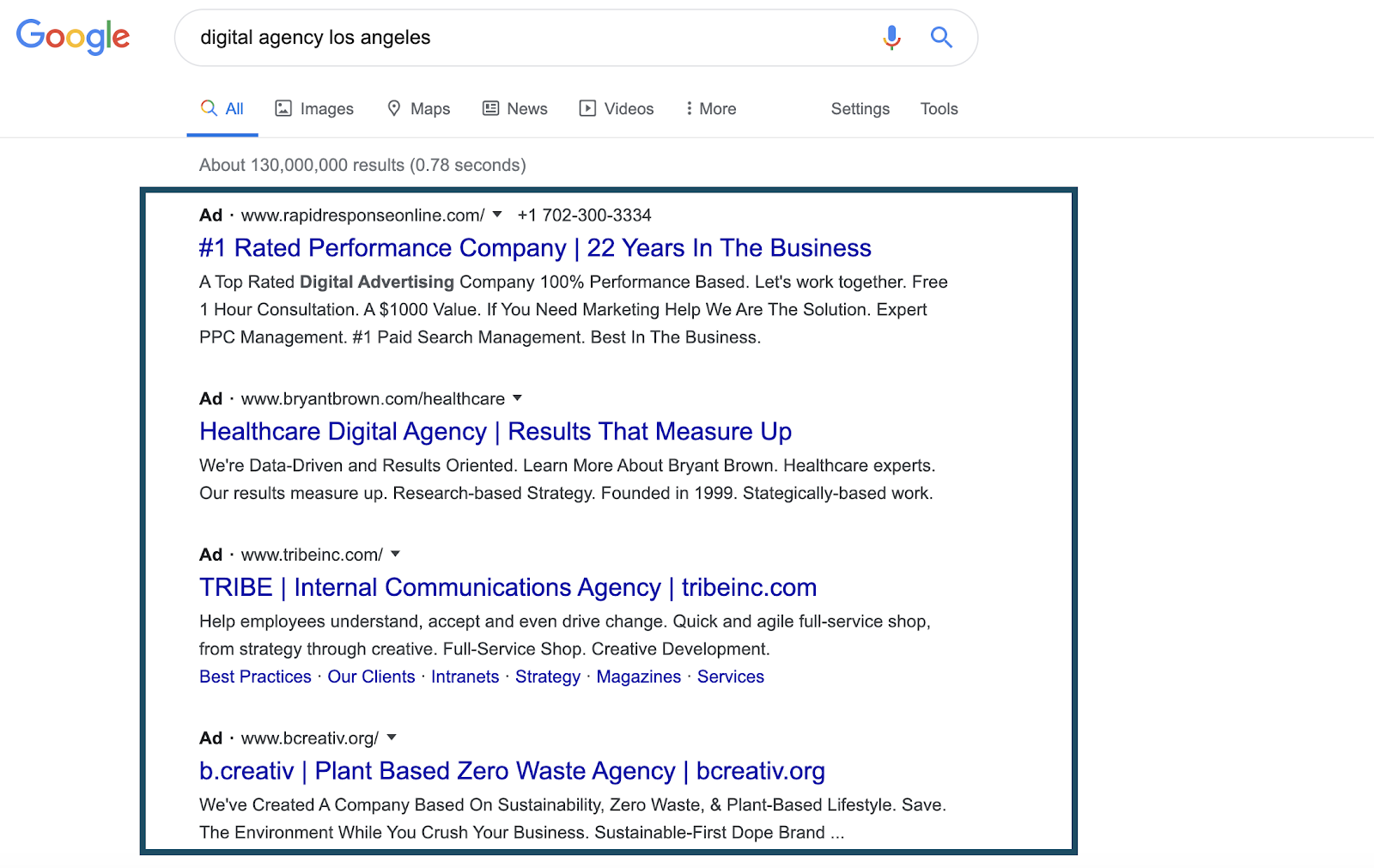Display advertising refers to the use of individual ad units like banners or videos/photo content on websites that do the obvious – advertise. Display ads are published on sites like Google Display Network, Facebook, etc. You’ll see these ads as banners, images, text, video, or animation on relevant third-party websites. Essentially, they are any kind of visual ad featured on a website. There are 3 types of display advertising: These ads are often seen at the top or along the sides of web pages. They are placed on distinct slots of a website that are reserved for paid advertising. Wider banners tend to perform better than tall and narrow ones. Google states that the top performing ad sizes are: Display advertising uses a push approach while search advertising uses a pull approach. Display ads are seen by users who are purposefully targeted. In other words, the ads users see depends on their online behavior. Search ads are seen by users who are actively looking for products or services that are similar to yours. Display advertising is also different from native advertising. Native advertising is a form of advertising that matches the look, feel, and function of the media format where the ads appear. Social media feeds or recommended content on web pages often contain these ads. Native ads help users of the website or platform easily consume the message of the ad. They are in-feed and non-disruptive. In other words, native ads blend in and soft-sell, while display ads stand out and hard-sell. It all depends on your marketing goals. If your marketing goal is to build brand awareness, generate leads, market with affiliate links, or retarget users, then it’s time you incorporate display ads to your campaign. To put it another way, it cultivates a feeling of wanting and needing compared to capitalizing on feelings that already exist. You’re essentially paying to have your ads featured across a variety of websites. If your goal is to get your brand in front of as many relevant users as possible, start using display ads. You can measure how successful your campaign is by tracking reach and impressions. Interactive elements like product feeds and in-banner searches can also be included to make your ad more interesting. You can track your campaign results by cost-per-acquisition (CPA) and click-through-rates (CTR). Affiliate marketing is the process by which an affiliate earns commission for marketing another brand’s products or services. The website owner promotes a company’s ad or affiliate network ads in exchange for a share of the sale or the conversion that comes from the ad. There are display ads that are specifically made for affiliate campaigns that encourage click-through. In order for your ad to work, it must stand-out and grab the user’s attention. Aim to create an ad that’s obvious, unique, and enticing. The offer of the ad should be something hard to refuse. Your display ads can act as a reminder to users who have shown interest in your business. You can read more about retargeting here. Aside from accomplishing your marketing goals, display ads have tons of other benefits. To begin, they provide businesses an opportunity to showcase their offers and products with different ad formats. In addition, you also have the potential to reach millions of users on websites around the world. Display advertising can help increase conversions and drive sales from users who might not have initially been interested in your brand. Therefore, your display ad can turn out to be a relevant solution to what those individuals were looking for. The best way to reap the benefits of display advertising is to target the right user on the right website. Knowing who to target and where can make your campaign successful can potentially increase your ROI. Furthermore, like all other content you upload or publish online, you need to optimize your display ads. You can do this by including keywords in your ads that can also be found in your landing page or homepage. Some other display advertising benefits are: Visual Appeal – Ads have to be visually appealing in order to work. You’re trying to grab the customer’s attention and visually communicate or convey your product’s/service’s main selling point. Since display ads are visual content, you can customize and design them to fit your brand’s personality. Display ads allow you to use graphics, photos, videos, audio, animation, or make your design more engaging. Creatively, you can do a lot more with display ads that you wouldn’t be able to do with search advertising. Effective Targets – Just like we’ve mentioned above, your display ads are only as good as the people you target them with. You need to customize and create specific parameters for your display ads. These include: which sites your ad will appear on, the location or geographic area they appear in, demographics, and a specific niche. This allows you to spend efficiently and not waste money on insignificant leads. Measurable Results – It’s important for businesses to track and analyze the results of their ad campaigns. Good or bad, the results provide valuable information. Having the opportunity to see what works and what doesn’t will contribute to making your next campaign better. Display ads can provide you that kind of data. You can measure and track your marketing activities through different analytic softwares like Google Analytics. You can examine exactly how many times your ad is seen and how many times it’s clicked on with this software. You don’t have to be a genius to implement display advertising in your marketing strategy. All you have to do is follow these 4 steps : To begin, you must create and assemble your ad. Use image and text elements to create an ad that fits the ad size you prefer. The first ad you make will act as a master creative or something like a template for future ad campaigns. Remember good display ads need to have: Split test your ad by scaling it out into different ad sizes. You’ll get better results if you mass produce your display ads and publish them into different sizes to work with multiple devices and screen sizes. Before you officially publish your ad and launch your campaign, make sure you’ve optimized your copy, images, and ad sizes. Next, you will need to upload each ad individually. It takes a lot of time and effort, so try using a software to help you publish and control ads with the push of a button. The work doesn’t end after publishing your ad. As we’ve said, one of the benefits of display advertising is the ability to track and measure your campaign costs, conversion rates, and your A/B test to see which image, copy, and ad size works best. *Tip : The next thing you can do to improve your display ad campaign is by creating a post-click experience that your audience will appreciate. Your display ad is only the first step to convincing visitors to continue their journey with your brand after they click on your ad. Please feel free to contact us if you have any questions or comments. We’d love to hear from you!Display Advertising – What Are Display Ads and When Do You Use Them?

What is Display Advertising?

“Google’s Display Ad Network reaches 90% of global internet users.” SEMrush

 There are other display ad sizes you can try like:
There are other display ad sizes you can try like:
Display Advertising VS. Search Advertising


Display Advertising VS. Native Advertising

When Should You Use Display Ads?
 Display ads are perfect for companies who want to increase brand awareness. Unlike search ads, they work to create a demand rather than answer it.
Display ads are perfect for companies who want to increase brand awareness. Unlike search ads, they work to create a demand rather than answer it. Generating leads can also be done with display ads. You can do this by luring a user to your website’s landing page to complete a purchase or fill out a form.
Generating leads can also be done with display ads. You can do this by luring a user to your website’s landing page to complete a purchase or fill out a form.

Retargeting is a marketing technique you can implement to get users to come back to your site and complete an action. When using retargeting, the users previous behavior on your website determines the display ad.Why Should You Use Display Ads?
Benefits of Display Advertising

How Display Advertising Works

STEP 1

STEP 2

STEP 3

STEP 4

With Just Digital,
Success is Easy-Peasy Lemon-Squeezy.
When life gives us lemons, we generate results. Contact us today and we can start making lemonade.






